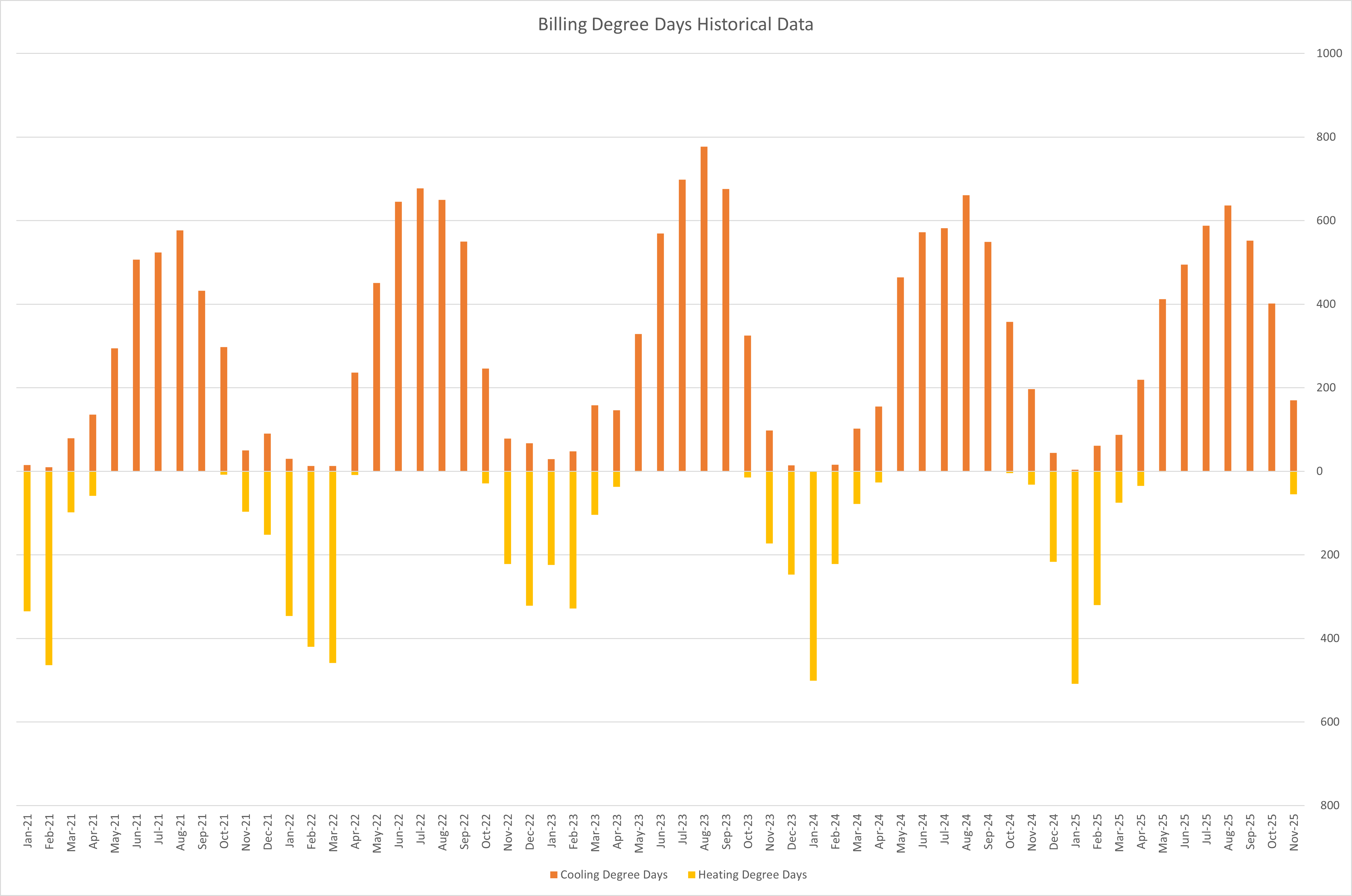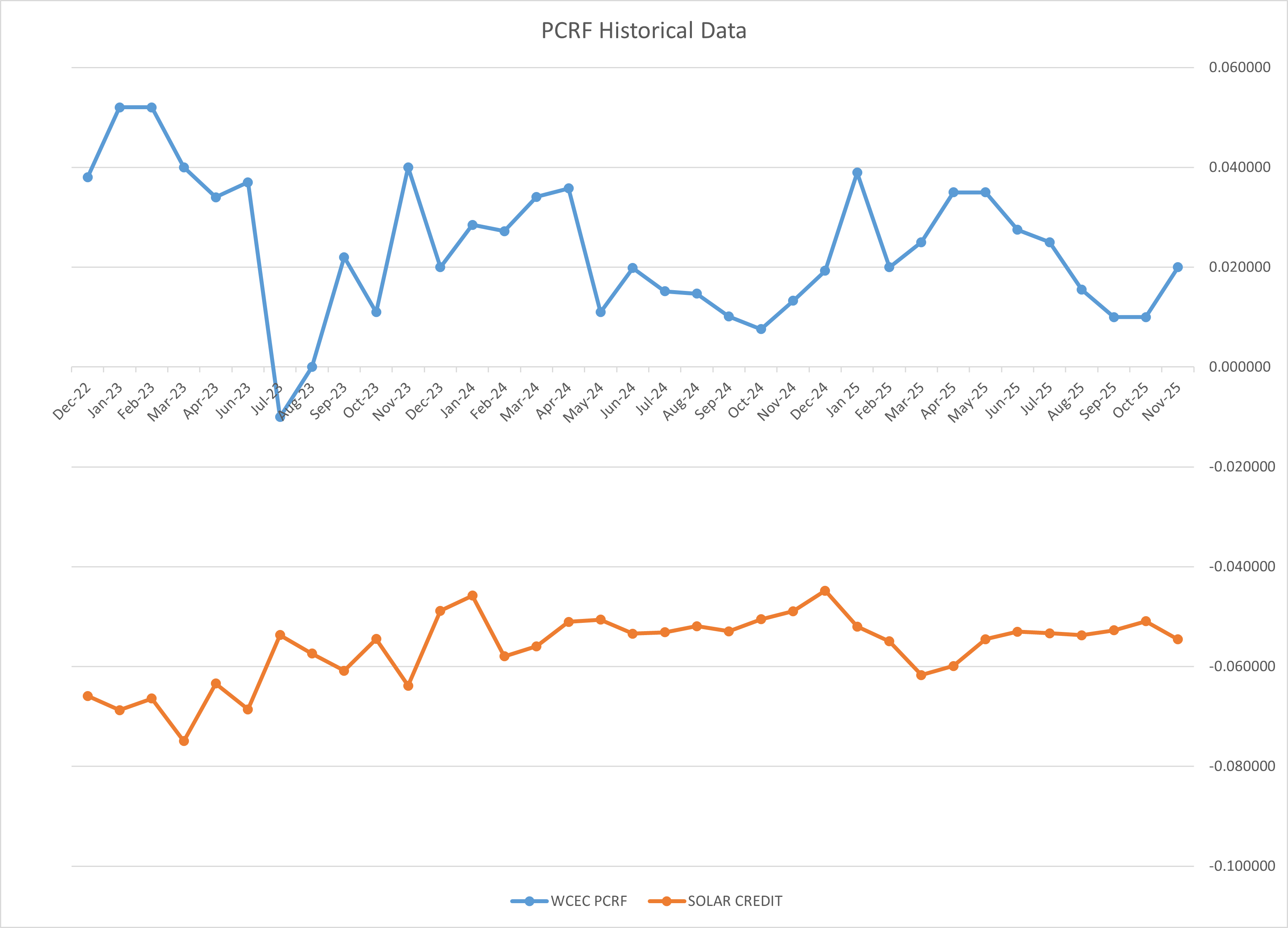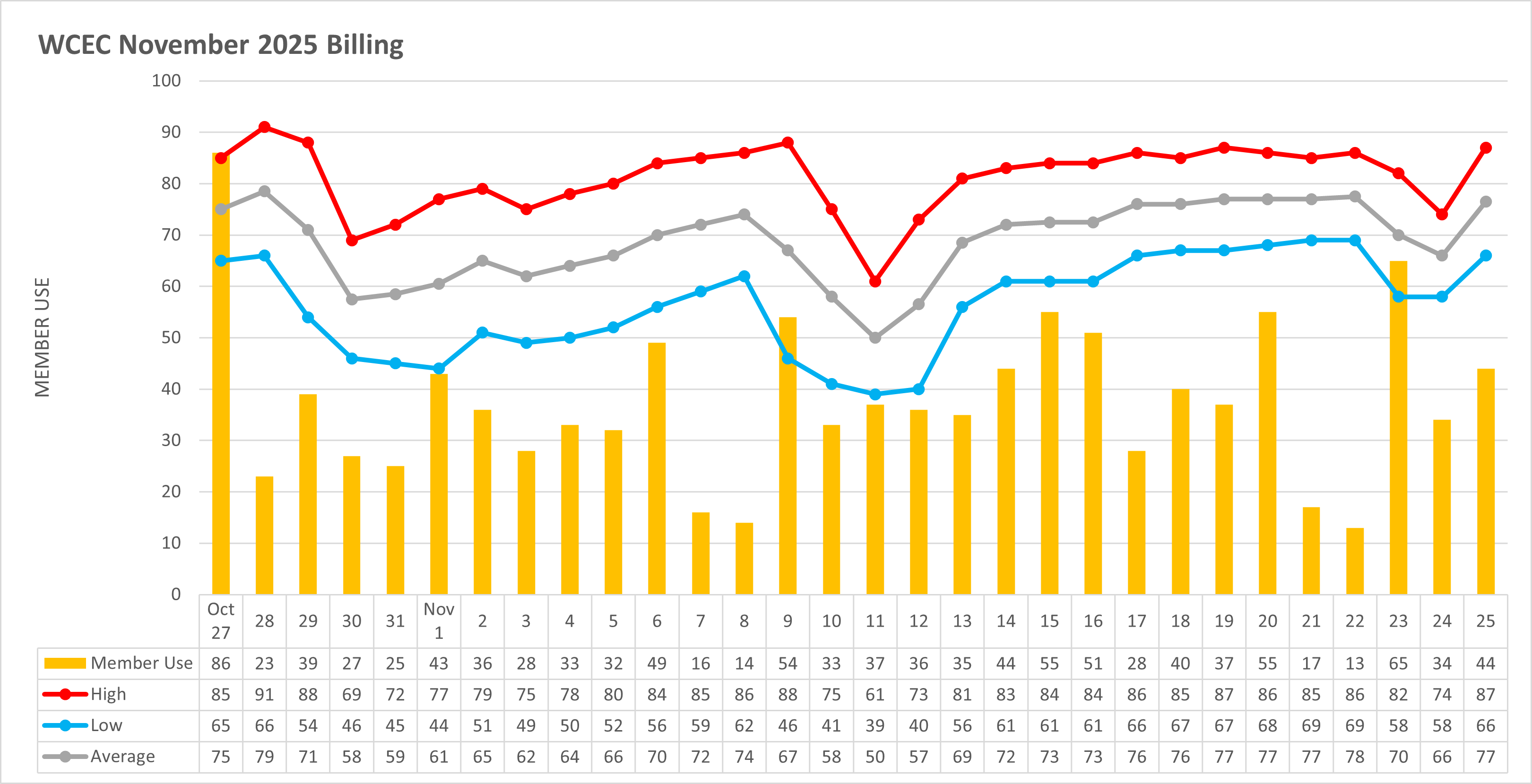Residential Billing Summaries
Two factors fluctuate each month on a WCEC residential electric bill: the member's usage in kWh and the PCRF.
Residential usage is affected most by the weather as this determines how long the A/C or heating will run. A/C and heating are the largest power-consuming devices in most homes. WCEC uses Billing Degree Days to measure the monthly temperatures as a way to gauge how high or low we expect our members' usage to be. When Billing Degree Days are highest, we expect higher usage and, in turn, higher bills.
The PCRF (Power Cost Recovery Factor) reflects the cost for the fuel used in generating the power we use on our system. These costs are incurred by STEC when power is generated and passed through to WCEC and its members through the PCRF. There is no markup on fuel cost by STEC to WCEC or by WCEC to our members.
The charts below show historical data for Billing Degree Days and PCRF (including Solar Credits for those with home solar panels):
Monthly Summaries
November 2025
Sample Residential Usage Based on 1,129 kWh of Power Consumed.
Billing Cycle: 28 Days - Oct. 27, 2025 - Nov. 25, 2025
SUMMARY:
Total residential use for November 2025 is 33% lower than last month, but 9% higher than November 2024 and 7% higher than the 10-year average for November. Average residential use per household is 1,021.
WEATHER:
The total billing degree days for this month are 44% lower than last month and 1.7% lower than in November 2024. This month's billing degree days are the second lowest for November in five years.
BILLING DEGREE DAYS:
Cooling Degree Days = 170
Heating Degree Days = 55
Total Degree Days = 225
SIMILAR DEGREE DAYS TO:
November and February 2024
PCRF:$0.02000 (↑ $0.01000)
October 2025
Sample Residential Usage Based on 1,276 kWh of Power Consumed.
Billing Cycle: 31 Days - Sept. 27, 2025 - Oct. 27, 2025
SUMMARY:
Total residential use for October 2025 is 15.5% lower than last month, but 7.5% higher than October 2024 and 18% higher than the 10-year average for October. Residential use for this month is the highest for October in the last 10 years. Average residential use per household is 1,516.
WEATHER:
The cooling degree days for this month are 27% lower than those for last month, but 11% higher than October 2024. This month's Cooling Degree Days are the highest for October in the last five years. No heating degree days were recorded.
BILLING DEGREE DAYS:
Cooling Degree Days = 402
Heating Degree Days = 0
Total Degree Days = 402
SIMILAR DEGREE DAYS TO:
February and May 2025
PCRF:$0.01000 (no change)
September 2025
Sample Residential Usage Based on 1,611 kWh of Power Consumed.
Billing Cycle: 31 Days - August 27, 2025-September 27, 2025
SUMMARY:
Total residential use for September 2025 is 8% lower than last month, but 5.7% higher than September 2024 and 7% higher than the 10-year average for September. Average residential use per household is 1,793.
WEATHER:
The cooling degree days for this month are 13% lower than those for last month and 0.5% lower than those for September 2024. This month's Cooling Degree Days represents the average CDD over the last five years for September.
BILLING DEGREE DAYS:
Cooling Degree Days = 552
Heating Degree Days = 0
Total Degree Days = 552
SIMILAR DEGREE DAYS TO:
September 2024 and June 2023
PCRF:$0.01000 (↓ $0.005500)
August 2025
Sample Residential Usage Based on 1,715 kWh of Power Consumed.
Billing Cycle: 31 Days - July 27, 2025-August 27, 2025
SUMMARY:
Total residential use for August 2025 is 7.3% higher than last month, but 2.5% lower than August 2024 and 1% higher than the 10-year average for August. Average residential use per household is 1,952.
WEATHER:
The cooling degree days for this month are 8.6% higher than last month, but 3.8% lower than August 2024 and 3.7% lower than the 5-year average for August.
BILLING DEGREE DAYS:
Cooling Degree Days = 636
Heating Degree Days = 0
Total Degree Days = 636
SIMILAR DEGREE DAYS TO:
June 2022 and August 2022
PCRF:$0.015500 (↓ $0.009500 )
July 2025
Sample Residential Usage Based on 1,582 kWh of Power Consumed.
Billing Cycle: 31 Days - June 26, 2025- July 27, 2025
SUMMARY:
Residential use for July 2025 is 7.7% higher than last month and 2.6% higher than July 2024. Average residential use is 1,826.
WEATHER:
Cooling Degree Days for this month are 26 above average for July.
**NOTE: You may notice that cooling degree days may seem higher than usual beginning this month. We have recalculated our Cooling Degree Days using a mean temperature of 65 degrees instead of 70 degrees to better align with industry standards.
BILLING DEGREE DAYS:
Cooling Degree Days = 588
Heating Degree Days = 0
Total Degree Days = 588
SIMILAR DEGREE DAYS TO:
June 2024 and July 2024
PCRF:$0.0250 (↓ $0.0025)
June 2025
Sample Residential Usage Based on 1,570 kWh of Power Consumed.
Billing Cycle: 30 Days - May 27, 2025- June 26, 2025
SUMMARY:
Residential use for June 2025 is 12% higher than it was in May 2025 and 7% lower than it was in June 2024. Average residential use is 1,703 kWh.
WEATHER:
Cooling Degree Days for this month are the lowest for June in the last five years.
BILLING DEGREE DAYS:
Cooling Degree Days = 495
Heating Degree Days = 0
Total Degree Days = 495
SIMILAR DEGREE DAYS TO:
June 2021 and May 2024
PCRF: $0.0275 (↓ $0.0075)
May 2025
Sample Residential Usage Based on 1,340 kWh of Power Consumed.
Billing Cycle: 31 Days - April 26, 2025- May 27, 2025
SUMMARY:
Residential use for May 2025 is 30% higher than it was last month and 4% higher than it was in April 2024. This is the highest residential use for May in 10 years. Average residential use is 1,512 kWh.
WEATHER:
Cooling Degree Days for this May are slightly above average, but 12% lower than last May in 2024.
BILLING DEGREE DAYS:
Cooling Degree Days = 412
Heating Degree Days = 1
Total Degree Days = 413
SIMILAR DEGREE DAYS TO:
May 2022 and September 2021
PCRF: $0.035 (no change)
April 2025
Sample Residential Usage Based on 1,149 kWh of Power Consumed.
Billing Cycle: 30 Days - March 27, 2025- April 26, 2025
SUMMARY:
Residential use for April 2025 is 18% higher than last month and 14% higher than April 2024. Average residential use is 1,163 kWh.
WEATHER:
Mild temperatures kept total billing degree days just above 250 this month. Your use this month should be at or near your home's base load.
BILLING DEGREE DAYS:
Cooling Degree Days = 219
Heating Degree Days = 35
Total Degree Days = 254
SIMILAR DEGREE DAYS TO:
November 2024 and March 2024
PCRF: $0.035 ( ↑ $0.010)
March 2025
Sample Residential Usage Based on 909 kWh of Power Consumed.
Billing Cycle: 30 Days - February 25, 2025 - March 27, 2025
SUMMARY:
Residential use for March 2025 is 33% lower than last month and 4% higher than March 2024. Average residential use is 989 kWh.
WEATHER:
Mild temperatures kept total billing degree days just above 150 this month. Your use this month should reflect your home's base load. Base load is the amount of power used without heating/cooling systems. Knowing your home's base load can help you pinpoint ways to be more efficient and detect problems throughout the year.
BILLING DEGREE DAYS:
Cooling Degree Days = 87
Heating Degree Days = 75
Total Degree Days = 162
SIMILAR DEGREE DAYS TO:
April 2024 and April 2023
PCRF: $0.025 ( ↑ $0.005)
February 2025

Sample Residential Usage Based on 1,445 kWh of Power Consumed.
SUMMARY:
Average residential use for February 2025 is 29% higher than last February, but 25% lower than last month. This month, average residential usage is 500 kWh less than last month, and the PCRF will be lower. Average residential usage is 1,495 kWh.
WEATHER:
Ten days of temperatures in the 30's or below with three days below freezing. Five days in the 80's.
BILLING DEGREE DAYS:
Cooling Degree Days = 61 (It is rare to register CDD in the double digits in February.)
Heating Degree Days = 320
SIMILAR DEGREE DAYS TO: February 2023 or December 2022.
PCRF: $0.02 ( ↓ $0.018)
January 2025

Sample Residential Usage Based on 1,975 kWh of Power Consumed.
SUMMARY:
Average residential use for January 2025 is 10% higher than last January. With an average monthly low equal to that of Winter Storm Uri and Heating Degree Days hitting a 5-year high, higher usage is expected. Average residential usage is 1,996 kWh.
WEATHER:
Twenty days of temperatures in the 30's or below with 12 days below freezing. Average low was equal to that of Winter Storm Uri.
BILLING DEGREE DAYS:
Cooling Degree Days = 4
Heating Degree Days = 509 (Highest HDD in five years)
SIMILAR DEGREE DAYS TO: January 2024 or February 2021
PCRF: $0.03895 (↑ $0.01966)












